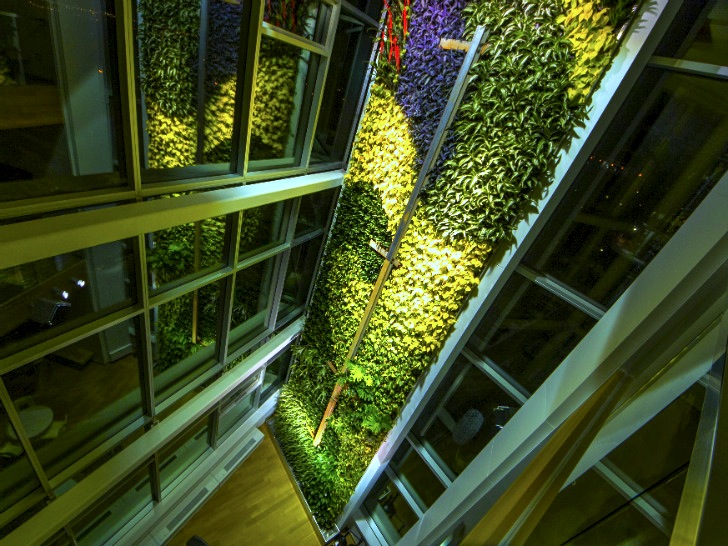
Green Over Grey’s newest project, “The Currents,” is conceptualized as a verdant wave that rises fifteen stories high along the interior wall of an office building. The piece was created for the Canadian financial services company, Desjardins Group, headquartered in Lévis and is literally a 2,139-square-foot hydroponic garden that begins in the buildings lobby and climbs, majestically to the top floor. Designer Mike Weinmaster took inspiration for the work from the nearby St. Lawrence river, using 11,000 plants, including philodendrons, snake plants, ginger, fig trees, and peace lilies as his palette. The result is the largest indoor living wall in the world.
The idea of a wall garden is actually an ancient art. One of the earliest examples, the Hanging Gardens of Babylon, was created in 290 B.C. Other plant walls have been found in many disparate societies, from Scandinavia to Japan. In the beginning of the 20th century, the ‘Jugendstil’ or Art Nouveau movement embraced these plant walls as a perfect synthesis of art and architecture. What has changed in the 21st century is that the technology of hydroponics has meant that these sculptures can be created and maintained on an entirely different scale.
Hydroponic gardens are built to sustain plans without soil. This is very important for an indoor wall garden, since soil is heavy and would be difficult to support vertically. The Currents is constructed on a unique frame of recycled plastic bottles and bags. Underneath, there is no soil, the plants absorb mineral nutrients through a carefully managed watering system. Overtime, their roots grow strong, supported by the vertical matrix, and become a perfectly balanced ecosystem.
As a piece of sculpture, The Currents is designed to be aesthetically pleasing, but the benefits of living art hardly stop there. Indoor foliage can actually improve air quality. A green wall is a natural air filter, purifying the air and releasing clean oxygen. Research has actually pointed to increased worker productivity, improved levels of concentration and fewer sick days. It’s even acoustically beneficial, since the plants cut down on noise levels.
Of course going green is also a ‘green’ response to energy consumption: walls made of plants actually help save energy. Plants help cool their environment anywhere from 3-7 degrees celsius through a process called transpiration. This means that a green wall can reduce overall energy consumption by 20%.
But most of the benefit of “The Currents” can be seen in how employees and onlookers engage with it everyday. It creates a space of tranquility and calm, much like the river that inspired its creation.





















 © 2017
© 2017
Recent Reviews